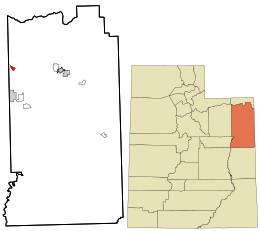Whiterocks, Utah facts for kids
Quick facts for kids
Whiterocks
|
|
|---|---|

Location in Uintah County and the state of Utah
|
|
| Country | United States |
| State | Utah |
| County | Uintah |
| Founded | 1868 |
| Named for | Whiterocks River |
| Area | |
| • Total | 2.4 sq mi (6.1 km2) |
| • Land | 2.4 sq mi (6.1 km2) |
| • Water | 0.0 sq mi (0.0 km2) |
| Elevation | 6,033 ft (1,839 m) |
| Population
(2000)
|
|
| • Total | 341 |
| • Density | 145.1/sq mi (56.0/km2) |
| Time zone | UTC-7 (Mountain (MST)) |
| • Summer (DST) | UTC-6 (MDT) |
| ZIP code |
84085
|
| Area code(s) | 435 |
| FIPS code | 49-84160 |
| GNIS feature ID | 1434208 |
Whiterocks is a small community in Uintah County, Utah, in the United States. It is known as a census-designated place (CDP). This means it is a special area set up by the government for counting people. In the year 2000, about 341 people lived there. This was a little more than the 312 people counted in 1990.
Contents
Where is Whiterocks?
Whiterocks is located in Utah. You can find it at these map coordinates: 40°28′3″N 109°55′47″W / 40.46750°N 109.92972°W. The community covers a total area of about 2.3 square miles (6.1 square kilometers). All of this area is land.
Who Lives in Whiterocks?
| Historical population | |||
|---|---|---|---|
| Census | Pop. | %± | |
| 1910 | 1,349 | — | |
| 1920 | 232 | −82.8% | |
| 1930 | 784 | 237.9% | |
| 1940 | 601 | −23.3% | |
| 1950 | 481 | −20.0% | |
| 1990 | 312 | — | |
| 2000 | 341 | 9.3% | |
| 2010 | 289 | −15.2% | |
| Source: U.S. Census Bureau | |||
In 2000, there were 341 people living in Whiterocks. These people made up 92 households and 78 families. Most of the people living there, about 94%, were Native American. About 6% were White or from two or more races.
Many households had children under 18 living with them. The average household had about 3 to 4 people. The community is quite young, with many people under the age of 25. The average age was 22 years old.
History of Whiterocks
Whiterocks has an interesting history, especially because of its connection to Native American tribes and early traders.
Early Trading Post (1828)
In 1828, four French traders from Kentucky came to the Uintah Basin. They included William "Toopeechee" Reed and Jim Reed. They set up a trading post near a spring of water. This spot was close to trails used by the local Ute people. The traders brought new items like butcher knives and coffee beans. They traded these for animal furs.
Later, in 1832, Antoine Rubidoux bought the trading post. He built a bigger "fort" nearby. This fort, called Fort Robidoux, was a busy place for fur traders for 12 years. However, in 1844, the fort was burned down.
Uintah Valley Reservation (1861)
On October 3, 1861, President Abraham Lincoln made an important decision. He ordered that the "Uintah Valley in the Territory of Utah" be set aside. This land was to be used only by Indian Tribes (Native American tribes). This became the Uintah Reservation.
Establishing the Agency (1868)
In 1868, Amos Reed, a government worker, visited White Rocks. His guide was Chief Antero of the Ute people. Chief Antero chose White Rocks as his home on the new reservation. He suggested that the Indian Agency (a government office for Native American affairs) be built there.
Chief Antero believed White Rocks was a good choice because it was in the center of the Basin. The local Utes often stayed there. Also, traders and trappers had already set up posts there. Many trails led to and from the area. The place also had a beautiful natural setting. Because of Chief Antero's suggestion, the agency moved to Whiterocks on Christmas Day, 1868.
Archaeological Discoveries
Near Whiterocks, there is an important archaeological site called "Whiterocks Village." This was a village of the Uinta Fremont people.
Excavation and Findings (1966)
In 1966, parts of the village were dug up by Wayne F. Shields. Experts believe the village was active between A.D. 800 and 950. During the dig, they found four round pithouses. These were homes built partly underground. They also found a rectangular granary, which was a building for storing grain. The granary had walls made of adobe (a type of mud brick).
Some of the pithouses had stone walls and central firepits. Others had single stone walls and no firepits. A small amount of human remains was also found.
Pottery and Tools
The site is famous for finding many pieces of Uinta Gray pottery. Over 5,600 pieces of pottery were found. Most of these were Uinta Gray, which is a special type of pottery made by the Uinta Fremont people. It is known for having calcite mixed into the clay.
Other items found included tools made from stone, shells, and bones. They also found nine corncobs and some beans. This tells us about the daily lives and farming practices of the people who lived there long ago.
National Register of Historic Places
The Whiterocks Village site is now listed on the National Register of Historic Places. This means it is an important historical place that needs to be protected. At the time of the excavation, much of the site's surface was being farmed. It was thought that farming had already damaged a lot of the ancient village.
See also
 In Spanish: Whiterocks para niños
In Spanish: Whiterocks para niños

